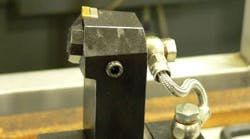As live tooling becomes more popular for CNC turning centers, the use of tooling with sealed bearings is becoming a challenge for shops that produce components in high volumes, or with lengthy cycle times.
Today, most common live tooling designs use sealed bearings that may be contaminated or overheat under heavy, repetitive use. This can diminish machining precision, reduce the service life of tools, and result in frequent and costly maintenance that compromises productivity.
“If a shop produces items that are high cycle or high volumes, then thermal growth will usually occur in the tool head,” explained Mike Thompson, lathe supervisor at Micro-Tronics, a precision machine shop producing metal valves and related products for aerospace and automotive manufacturers. “This is because the sealed bearings in the tool head tend to overheat during continuous use or under heavy loads, and that can cause serious problems.”
Among the problems that Thompson experienced with live tools that have sealed bearings was thermal growth causing offset deviations that adversely affected workpiece tolerances. In another instance, metal chips entered and fouled the tool head bearing after the bearing seal had failed.
To avoid those problems Thompson’s company recently acquired a novel tool holder for each of its new Okuma LB300 lathes – a tool holder with a coolant-fed, or externally cooled, bearing assembly from Planet Products Inc. PPC has developed a patented, live-tool design for turret lathe applications that uses a continuous flow of filtered machine coolant to lubricate and cool the bearings, eliminating many of the existing failure modes.
Unlike conventional bearings, coolant-fed bearings do not rely on seal integrity or the lubricant packing to keep bearings operating normally, even under stressful conditions. Instead, the filtered coolant used to externally cool and lubricate the live tools and workpieces is directed to flow through the tool, keeping the bearings cool and maintaining accuracy.
Conversely, conventional tooling is designed to prevent coolant from contacting bearings because in the event that coolant contacts the bearing’s grease packing, sludge will form will hinder bearing functionality, and eventually cause failure.
Thompson notes that, in some cases when bearing seals fail, foreign objects like metal shavings from the workpiece can contact the bearing and cause failures. With the externally cooled and lubricated coolant-fed bearing design, this danger is virtually eliminated because the coolant will wash any metal chips or other contaminants away from the bearing assembly.
Pushing the limits
In addition to standard coolant-fed live tools for turret lathe applications, PPC has developed a line of “speeder” over-speed heads. These heads feature a gear-up ratio that allows the tool to spin faster than a turret drive. For example, if the user has a 4,000-RPM turret, they may be able to get 12,000-15,000 RPM with a sped-up ratio. This increased speed, along with the coolant-fed bearing feature, is advantageous for lathe operations with high-cycle, high-volume requirements, enabling them to process components considerably faster with dramatically increased tool service life.
Those benefits have been significant to manufacturers like Buku Performance Products, a small producer of high-performance aftermarket components for radio-controlled vehicles.
“We compete directly against overseas manufacturers located in lower-cost environments, so production costs are always a concern for us,” said Dave Maslar, CEO. “Making an investment in new tooling is a serious one that we consider carefully to ensure that we are improving the efficiencies of our existing production equipment.”
When Maslar learned that PPC offered an over-speed live-tooling head that matched his shop’s Daewoo (Doosan) Puma 240MB turret lathe, he decided to see if that head could help Buku increase throughput of its aluminum parts.
“Our cycle time was approximately six-and-a-half minutes and over four of those minutes we’re holding a 3/32 end mill to machine aluminum and cut deep slots,” Maslar explained. “The live-tool turret on my machine is limited to 5,000 RPM. That was the limiting factor for the time that it was taking to produce these components. So, the over-speed appeared to be a good way to address that issue.”
Cutting cycle time
By using the over-speed head Maslar was able to reduce the cycle time by more than two minutes. Tool cutting reliability and accuracy were maintained, even though the cycle time placed a heavy demand on the tool.
“The bearings are running fast and they are running for a long time,” according to Maslar. “But, having the coolant lubricate the bearings eliminated any concerns we could have had regarding overusing the a live tool for that amount of time.”
Maslar added that when bearings are externally lubricated and cooled, as with the PPC over-speed tool, the bearings tolerances can be tighter — which improves the runout characteristic in the bearing.
There is an upper limit to the how tight bearing can be if the tool it’s in will be running for a long time, he noted. Yet, Buku has experienced a significant improvement in runout that Maslar attributed to the active, external cooling and lubrication of the bearings in the tool head.
“That’s a very important result because I’m running a 3/32-in., three-flute end mill, and the feed-per-revolution is distributed among three cutting teeth,” he explained. “Even the slightest bit of runout can cause one tooth to substantially overcut, wear faster, and the tool will fail more quickly than it should. From a tool cost that may be no big deal; but from a production-downtime standpoint, that may be very expensive.
“So far, we’ve not broken one end mill,” Maslar said, “and that reflects cutting times of 20-30 hours on a single end mill.”
He added that although Buku’s operation is cutting aluminum, which is a soft material, shops that are cutting very hard materials should have an even greater appreciation for the tool runout improvements, because runout is usually a very significant issue in pushing the limits of a machining operation.







